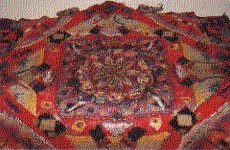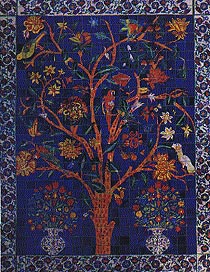|
The influence of Central Asian textiles on contemporary
design can be seen in particular in furnishings. This includes
floor rugs, wall hangings, upholstery and cushions.
Activity
| 1.
|
Look
through interior design magazines and create a montage
of contemporary design influenced by Central Asian textiles. |
| 2.
|
Examine
Figures 11–13 and read the quotes from the three
textile designers: Lou Houbein, Ing Flint and Susan
Schapira. Write a paragraph on the impact of Central
Asian culture on textile arts. |
|
Houbein, L. (1992) Designing on the needle, Textile
Fibre Forum, No 34, pp. 22–23, 58.
|
Discarding
the many elaborate stitches I had mastered,
I returned to tent stitch to make Oriental rugs
to the scale of a doll's house - with a mini
carpetbag face, loosely based on an Uzbeki design.
A black and white, rather fuzzy photo of a Persian
palace carpet led me to use graph paper for
the first time, to see if the design would translate
to tent stitch. I worked out a border and one
corner. My very free interpretation (a mere
32 x 55 cm) was entirely executed in fine knitting
yarns on a canvas with medium holes. (Houbein,
1992:22)
I
began to long for something big and bold after
this miniature eye-squeezer, and bought coarse
canvas and seven delicious skeins of thick rug
wool in deep orange, mustard, moss, sky-blue,
brown, black and white. Not quite primary colours,
but loud and clear — and far from subtle.
As I worked this 60 x 120 cm canvas, in tent
stitch to achieve detail, I leaned heavily on
Kazak rug patterns and Middle Eastern embroidery.
It acquired the nickname of 'King Arthur's Barbaric
Splendour' in family circles. (Houbein, 1992:22)
|
 Fig.
11 Palace rug (Houbein, 1992:23)
Fig.
11 Palace rug (Houbein, 1992:23) |
|
Lawrence,
K. (1998) Twisted, tangled and matted: Feltworks by
Ing Flint, Textile Fibre Forum, No 51, pp. 13,
25.
| In
constructing images the conventions of textiles
are employed: the use of repetition to build up
fields of pattern, images worked in the round,
radiating out from a central core, or repeated
and varied along a narrow strip. Many of the works
refer to textile traditions, particularly the
influence of Middle Eastern textiles on the west.
Byzantine fragment, Prayer mat and Scheherezade's
doormat echo the patterned richness of Persian
rugs and the cultural narratives of their symbolism.
(Lawrence, 1998:13) |

Fig.
12 Byzantine fragment (Flint in Lawrence, 1998:13)
|
|
Schapira,
S. (1999) Susan Schapira, Contemporary Reverse Applique,
Textile Fibre Forum, No 56, p. 10.
| I
work in fabric to express images that come to
me from life — from nature, art, literature
and prayer. Textiles have an energy and sensuality
unlike any other medium, and this enhances the
creative process for me. I favour working with
my hand-dyed cottons and silks because of their
depth, intensity, colour range and luminosity.
I also love to use ethnic textiles — Guatemalan
weavings, molas from the Cuna Indians, African
mud cloth and kuba cloth, Afghani and Pakistani
needlework, Japanese kimono and obi, Bedouin embroidery
and vintage American lacework. With my art quilts
and wearable art, I hope to honor the spirit of
the person who created these textiles, and to
honour the creative spirit in all of us. (Schapira,
1999:10) |

Fig.
13 Wanderings, 64.5" x 91.5", made 1998.
Machine pieced, raw edge reverse applique, machine-and
hand-quilted. Hand-dyed cottons, hand-painted
batik silk by Els van Baarle, Afghani fringed
tapestry, Pakistani embroidery, Bedouin embroidery,
Guatemalan ikat, acrylic paint. |
|
|
Multicultural
tree
This tile mural was created by fifty-two Year
9 to Year 12 students studying ceramics. It
took approximately one term to complete. The
multicultural dimension for the mural came from
many sources, including an old Celtic bedspread,
Indian embroidery, Australian wildlife photos
and an old Persian design.
Lyn
Goodwin, Principal
Anne Smith, Visual Arts teacher
Arthur Phillip High School
Parramatta District
|

Fig.
14 Multicultural Tree |
|
|